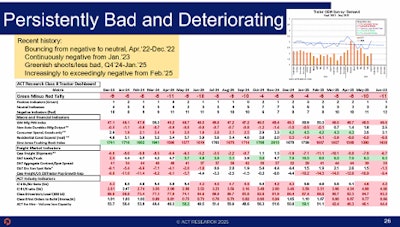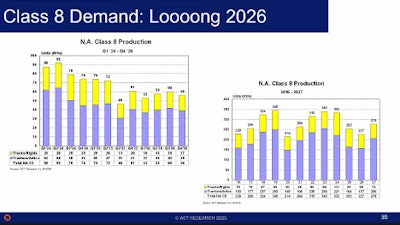Kenny Vieth, president and senior analyst at ACT Research, was introduced at the MEMA Commercial Vehicle Outlook Conference on Tuesday as bringing good news. And there was, but much like the market today, it’s going to be a slog to get to it.
“We are really pulling back hard on the slingshot of demand,” Vieth says. “When it does go, you’re all going to be making hard decisions.”
Part of the pulling back comes from uncertainty around federal economic policies, including tariffs, spurring rising inflation and lower disposable personal income, and flat manufacturing, none of which are good for trucking.
“If you have to spend 5% more on a product, that’s 5% less product going in the back of the trucks,” Vieth says.

Here’s some of the good news: The U.S. economy was in very good shape at the beginning of this volatility. Vieth says it started turning as tariffs rose from 2.4% in 2024 to 18.6% today with a possibility of hitting 22%. That means, he says, the average U.S. household will spend $2,400 more this year to buy the same things they did last year.
“The challenge of planning any business activity in this is very difficult,” Vieth says.
And it’s going to get worse before it gets better.
Vieth says the payback for any freight pull forward this year is coming. For 2026, ACT predicts a mere 1% freight growth, which will make it even harder to get past overcapacity in the economy. Spot rates, he says, aren’t even keeping up with inflation, and since spot rates “are the data point from which all other carrier profitability data flow,” Vieth says next year is going to be a long one.
Here's more of the good news: Daycab orders are down — 37% of Class 8 orders as opposed to a 41% long-term average — which isn’t a great sign for tractor production, but could be a sign overcapacity in the market is starting to correct. That’s backed up by fleets surveyed by ACT saying it’s getting more difficult to find drivers.

Continuing with the bright spots, Vieth moved on to say, eventually, pent-up demand in the form of aging fleets will force an inflection, just maybe not in 2026.
“It shouldn’t take a lot to move the industry in a positive direction,” he says, maybe in 2028.
In the near term, Vieth says ACT is watching for EPA Clean Truck announcement at the end of the third quarter with a more imminent decision on Section 232 tariffs on Class 8 trucks possibly by the end of the month. He also sees “a pop” in orders as books open in the fourth quarter and fleets look for replacements.
There could also be something to like in the vocational market, Vieth says, as buyers in some markets still have room to buy. However, the forecasts are bleaker for trailers. Vieth says as bad as the outlook is, it may not be pessimistic enough. One possibility for hope is in the refrigerated trailer fleet, which will soon be as old as it has ever been.
Used truck prices are higher, Vieth says, as new equipment prices jump because of steel and aluminum tariffs when buyers already aren’t making money. There are also inventory headwinds in the Class 8 market.
“We should have about a 55,000 Class 8 inventory relative to long-term averages,” Vieth says. “We’re right at 90,000 units. That’s 35,000 too many Class 8 inventory units.”
History shows inventory burns at about 2,000 units per month and, while rising inflation may help increase the rate a little, it will still take more than a year to drive through the excess number of trucks. Vocational and medium duty aren’t in much better shape, with the market carrying about twice as many trucks as there are historically.
“We have to grind through excess capacity and, unfortunately, time is the cure for that,” Vieth says.
One optimistic corner of the market is school buses.
“I do think we still have school buses left,” he says. “If all you do is supply school buses, you’re still killing it.”










